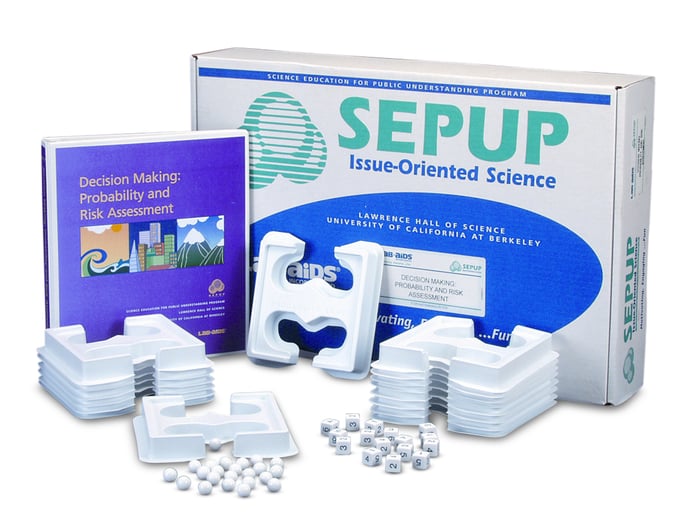Decision Making: Probability and Risk Assessment (Developed by SEPUP)

Marble-rolling activities, number cubes, and coin tosses are used to introduce probability. After reading several historical case studies, students are presented with a hypothetical life-or-death decision involving an epidemic disease. They are asked to make recommendations about ways to reduce the risks associated with local emergency or disaster situations that could be either natural or human-caused.
The learning emphasis is placed on student understanding of trade-offs and decisions.
Accommodates five classes, each with 8 groups of four students.
This module includes a Teacher Guide
More Info
1. Estimating Probabilities
Students discover some of the principles of scientific investigation as they learn about chance. They attempt to roll a marble into an opening in a tray and discuss the variables involved. Students then design and carry out controlled investigations to compare the probabilities of rolling a marble through large and small openings.
2. Surveying a Population
Students are introduced to survey research techniques and the importance of developing unambiguous questions. They apply these ideas by constructing and conducting a survey of a target population at school on an acceptable issue identified by, and of interest to, the students.
3. Comparing Risks of Injury
Student groups rank the risks of a selected category of activities or objects according to how often they think injury occurs. Each group chooses the ten items in its category that it thinks most frequently result in injuries and then predicts the rank order of the injury rates. During the discussion of this process, the class begins to develop an operational definition of risk.
4. Evaluating Evidence of Risk
Using data tables with evidence about the injury rate for each risk category in Activity 3, student groups compare the actual data to their previous rankings and discuss the extent and quality of reported evidence for each category. This introduces the concepts of sampling techniques, the effect of bias, and limitations of the data resulting from the way it is collected. The operational definition of risk is developed further.
5. Risk Analysis and Reduction
Students present, categorize, and discuss pictures showing that all activities involve risk. The relationship between risk and life is addressed, and the concept of voluntary and involuntary risks is introduced. Using the data they investigated in Activity 4, groups discuss how to reduce risk.
6. Analyzing Survey Data
Students bring in the data they collected during the survey in Activity 2 and analyze it, looking for evidence about the risks involved. The activity culminates in students writing a letter to the school principal or a local newspaper explaining the data they gathered and the conclusions they can draw from their data.
7. Investigating Chance and Probability
Students flip coins to collect quantitative data over time and use it to determine the probability of a single event occurring. The importance of sample size and randomness in experimental data is emphasized. Students then apply what they have learned to designing an investigation to determine the probability of getting a marble into an opening in a tray as they did in Activity I.
8. Making Decisions with Limited Experience
Students read and react to a simulation requiring them to make a personal decision based on limited information. The need in life to make decisions without complete evidence is introduced. The difference between group and individual decision making is discussed. Students consider the concept of trade-offs and the fact that personal decisions are based not only on objective evidence but also on other subjective factors.
9. Quantitative Risk Analysis
Continuing their work in Activity 8, students read about and react to the history of inoculations and immunizations in the fight against smallpox. Ethical issues in the practice of medicine are investigated from a historical perspective. Students are asked to consider an issue from a doctor’s point of view and to make life and death decisions involving risk comparison.
10. Investigating Cumulative Risk
Students investigate chance and probability using number cubes much as they did in the coin investigation in Activity 7. They begin to explore the probability of repeated events more deeply, extending it to the concept of cumulative risks. Students then apply what they have learned to the injection problem data from Activity 8.
11. Risk Mitigation
Students apply what they have learned about risk and risk reduction to preparing for the risks involved in a specific natural disaster. They develop a personal family risk-management plan and come to understand that effective preparedness can mitigate or reduce the risk of all natural disasters.
Scientific Concepts
- Important personal decisions are made based on ones’ perception of risk. Risk analysis considers the type of risk, the frequency of consequences, and the severity of the consequences.
- Probability estimates can be applied to health risks and used to weigh the risk against estimated personal and social benefits.
- Everyday risks can result from both natural and human-made hazards. Risks can be identified so that they can be avoided or, if unavoidable, preparedness plans developed.
- Gathering relevant evidence is essential for thoughtful inquiry and good decision making.
- Making decisions about complex issues often involves trade-offs and evaluating issues requires an analysis of both risks (costs) and benefits.
Guides & Student Sheets
Our kits and modules provide you with everything you need so you can open, review, and teach the material confidently the next day.
- Full downloadable Teacher Guide with background information, detailed instruction, example data and answers
- Downloadable Student Sheets with age appropriate background information, full procedure(s), and analysis questions
- All materials necessary to carry out the investigation
- Safety Data Sheets
Module Components
- 1 Teacher’s Guide with reproducible masters for Student Sheets
- 16 LAB-AIDS® Probability Trays
- 16 Marbles, 9/16"
- 16 Dice
